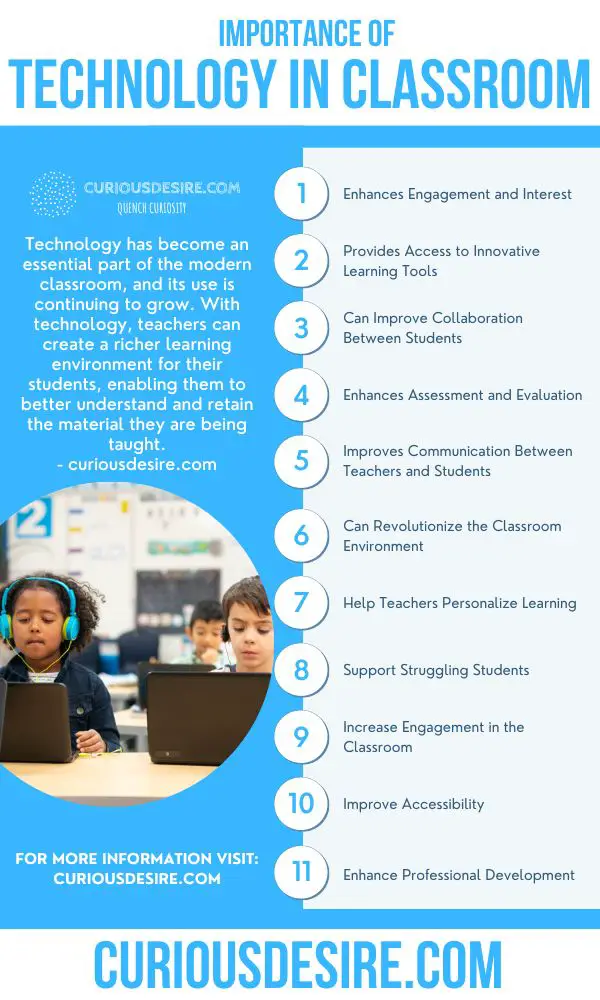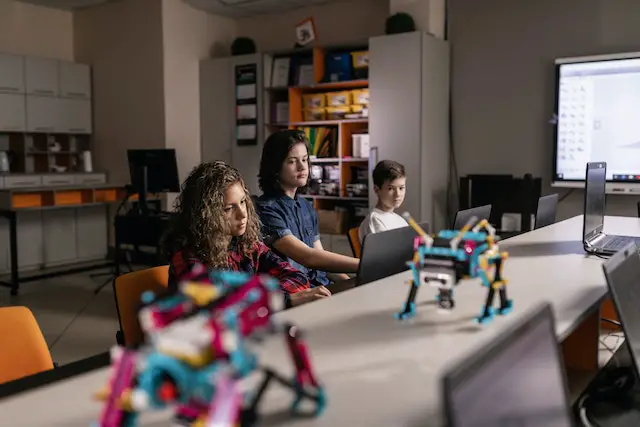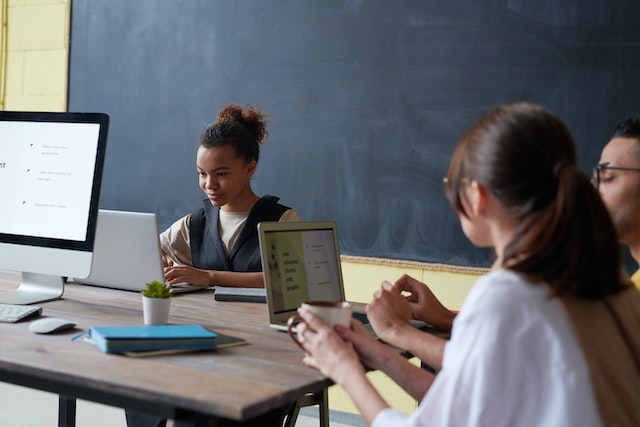Technology has become an essential part of the modern classroom, and its use is continuing to grow. Technology can provide teachers with new ways of engaging students, give students access to innovative learning tools, and even revolutionize the way classrooms are organized.
With technology, teachers can create a richer learning environment for their students, enabling them to better understand and retain the material they are being taught. In this article, we’re going to explore 15 reasons for the importance of technology in the classroom.
15 Benefits of Technology in Classroom
Technology in the classroom is a major influence on teaching and learning. Here are the top 15 reasons why technology is so important in the classroom:
1. Technology in Classroom Enhances Engagement and Interest
Students are more likely to be engaged and interested in learning when technology is involved. Technology can help make class time more interactive, allowing students to have hands-on experiences with new concepts.
Through the use of technology, teachers can also create engaging presentations that help to keep students from becoming bored. For instance, teachers can use multimedia tools to create interactive lessons that are visually stimulating and engaging.

2. Technology Provides Access to Innovative Learning Tools
By incorporating technology into the classroom, students have access to a range of innovative learning tools. These tools can help teachers present material in new and interesting ways, as well as give students more control over their own learning.
For instance, online educational platforms can provide students with access to interactive lessons and resources, while teacher-created apps can give students the opportunity to create and manage digital portfolios.
3. Technology Can Improve Collaboration Between Students
Technology can make it easier for students to collaborate on projects and assignments. Through tools like Google Classroom and Zoom, students can easily share documents and hold virtual meetings with one another.
This level of collaboration can help to foster a sense of community in the classroom and encourage students to work together more effectively.
4. Technology Enhances Assessment and Evaluation
Technology can also be used to track student progress and create more effective assessment and evaluation processes. For instance, teachers can use online quizzes and tests to evaluate student understanding in a more accurate way.
This technology can help teachers identify areas where students have difficulty and quickly adjust their teaching plans accordingly.
5. Technology Improves Communication Between Teachers and Students
Technology makes it easier for teachers to communicate with students outside of the classroom. This can help build relationships and provide teachers with a better understanding of their students’ needs.
For instance, teachers can use email and messaging platforms like Slack to quickly send messages to students or answer any questions they may have.
Suggested Readings
Importance of Technology in Society
6. Technology Can Revolutionize the Classroom Environment
Technology can also be used to create a more organized and efficient classroom environment. For instance, teachers can use scheduling software to easily plan their lessons and activities.
In addition, technology tools like QR codes can help streamline the process of checking in students and tracking attendance.

7. Technology Can Help Teachers Personalize Learning
Technology can be used to create personalized learning experiences for students. For instance, teachers can use data collected from student assessment tools to customize their lesson plans and activities based on each student’s individual needs.
This type of personalization can be extremely beneficial in helping students develop a deeper understanding of the material they are studying.
8. Technology Can Help Support Struggling Students
Technology can be used to support students who are struggling with their studies. For instance, teachers can use online tutoring platforms and learning tools to provide extra help for those students who need it.
This type of personalized instruction can help struggling students build confidence in their own academic abilities and ultimately achieve success in the classroom.
9. Technology Can Increase Engagement in the Classroom
Technology can help to increase engagement in the classroom by providing students with a variety of interactive activities and learning tools. For instance, teachers can use educational games, virtual reality simulations, and augmented reality experiences to make lessons more exciting and engaging for students.
In addition, teachers can use technology to create interactive projects and activities that require students to work together in order to succeed.
10. Technology Can Help Improve Accessibility
Finally, technology can help to improve accessibility for all students, regardless of their abilities or learning styles. For instance, teachers can use text-to-speech software and other assistive technologies to make lessons more accessible to those students who may not be able to read or understand the material.
Additionally, teachers can use technology to create digital content that is easier for all students to access and navigate. With the help of technology, teachers can create a more inclusive and accessible learning environment for all students.
Suggested Readings
Importance of Technology in Education
Importance of Technology in Healthcare
Importance of Technology In Our Life
11. Technology Can Enhance Professional Development
Technology can also be used to enhance the professional development of teachers. For instance, teachers can use online platforms and tools to stay up-to-date on educational trends and best practices.
In addition, they can access resources to help them refine their teaching strategies and create more effective lesson plans. With the help of technology, teachers can ensure that they are always on top of the latest developments in education.

12. Technology Can Reduce Paperwork
Technology can help reduce the amount of paperwork teachers have to manage. For instance, teachers can use online platforms and tools to streamline their grading process and eliminate the need for paper assignments and tests.
They can use digital portfolios to store student work instead of filing papers in stacks or folders. By taking advantage of technology, teachers can save time and energy that would otherwise be spent on administrative tasks.
13. Technology Can Help Bridge the Digital Divide
Technology can help bridge the digital divide between students from different backgrounds or socioeconomic statuses. For instance, teachers can use online platforms and tools to provide equitable access to resources and instruction for all students.
They can also use video conferencing tools to connect their students with experts from around the world and provide them with a richer learning experience. By using technology, teachers can ensure that all of their students have access to the same educational opportunities.
14. Technology Can Increase Student Achievement
Technology can help to increase student achievement by providing students with access to resources and tools that can help them succeed. For instance, teachers can use online platforms and tools to provide real-time feedback to their students and help them improve their understanding of the material.
They can also use learning management systems (LMS) to track student progress and provide personalized learning experiences. With the help of technology, teachers can ensure that their students have a greater chance at academic success.

15. Technology Can Strengthen Teacher-Student Relationship
Finally, technology can help to strengthen the relationship between teachers and students by creating opportunities for more meaningful interactions. For instance, teachers can use video conferencing tools to connect with their students on a regular basis and build relationships outside of the classroom.
They can also use social media platforms to stay in touch with their students and provide them with emotional support. By leveraging technology, teachers can create a more positive learning environment for their students and foster meaningful connections.
Suggested Readings
Importance of Technology in Education Essay
Importance of Technology in Communication
Importance of Technology in Business
Conclusion
In conclusion, technology offers a wide range of benefits for teachers and students. By using the right tools and platforms, teachers can ensure that their students have access to the resources they need to succeed in the classroom. Technology can help reduce paperwork, bridge the digital divide, increase student engagement and achievement, and strengthen teacher-student relationships.
With the help of technology, teachers can create engaging and accessible lessons that foster meaningful learning experiences for their students. Overall, technology can be an invaluable tool for educators. By taking advantage of its many benefits, teachers can ensure that all of their students have access to quality educational resources.
Relevant Articles
Importance of Technology in Society
Importance of Technology in Education
Importance of Technology in Healthcare
Importance of Technology In Our Life
Importance of Technology in Education Essay